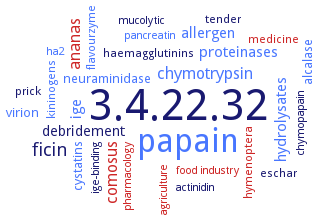3.4.22.32: Stem bromelain
This is an abbreviated version!
For detailed information about Stem bromelain, go to the full flat file.

Word Map on EC 3.4.22.32 
-
3.4.22.32
-
papain
-
ficin
-
comosus
-
chymotrypsin
-
ananas
-
hydrolysates
-
allergen
-
proteinases
-
ige
-
debridement
-
neuraminidase
-
alcalase
-
cystatins
-
virion
-
hymenoptera
-
flavourzyme
-
medicine
-
kininogens
-
prick
-
eschar
-
tender
-
haemagglutinins
-
food industry
-
actinidin
-
ha2
-
agriculture
-
chymopapain
-
mucolytic
-
pharmacology
-
pancreatin
-
ige-binding
- 3.4.22.32
- papain
- ficin
- comosus
- chymotrypsin
- ananas
- hydrolysates
- allergen
- proteinases
- ige
-
debridement
- neuraminidase
- alcalase
- cystatins
- virion
- hymenoptera
- flavourzyme
- medicine
- kininogens
-
prick
-
eschar
-
tender
-
haemagglutinins
- food industry
- actinidin
- ha2
- agriculture
- chymopapain
-
mucolytic
- pharmacology
- pancreatin
-
ige-binding
Reaction
broad specificity for cleavage of proteins, but strong preference for Z-Arg-Arg-/-NHMec amongst small molecule substrates =
Synonyms
acidic bromelain stem proteinase, ACMD2_17643, BRM, Bromelain, Bromelain, stem, EC 3.4.22.4, EC 3.4.4.24, Pineapple stem bromelain, SBA, Sbm, stem bromelain
ECTree
Advanced search results
pH Stability
pH Stability on EC 3.4.22.32 - Stem bromelain
Please wait a moment until all data is loaded. This message will disappear when all data is loaded.
0.8 - 2
-
stem bromelain at pH 2.0 is maximally unfolded and characterized by significant loss of secondary structure (about 80%) and almost complete loss of tertiary contacts, at pH 0.8 a molten globule state is observed with secondary structure content similar to that of native protein but no tertiary structure
680545
3.2 - 7
-
stem bromelain solubilized at pH 7.0 and at pH 3.2 retains, after 16 h at 256°C, 10 and 40% of the initial activity, respectively
731526
5.5 - 10
-
stem bromelain is fully resistant against urea around neutral pH (5.5 to 10.0) and unfolds only below pH 5.0
707537
7 - 10
-
from pH 7.0 to 10.0, the protein's secondary structure remains the same, although a slight loss of tertiary structure is observed. Above pH 10.0, there is a significant and irreversible loss of secondary and tertiary structure. At pH 10.0, SBM shows a significant increase in 8-anilino-1-naphthalene-sulfonate binding relative to the native state. No significant loss of activity is observed up to pH 10.0, beyond which there is an irreversible loss of activity
707283


 results (
results ( results (
results ( top
top






